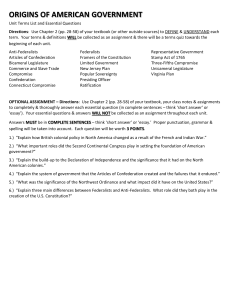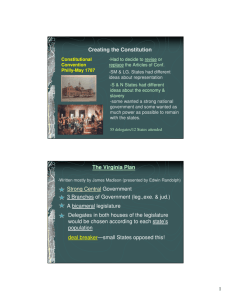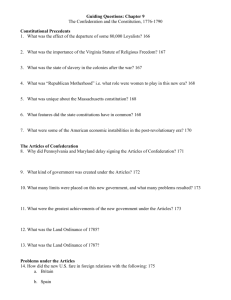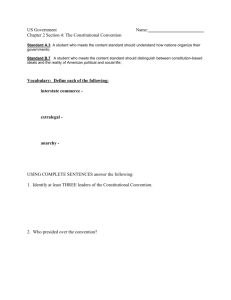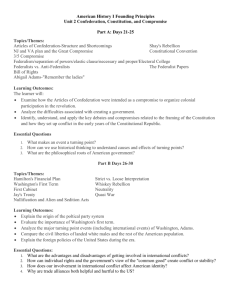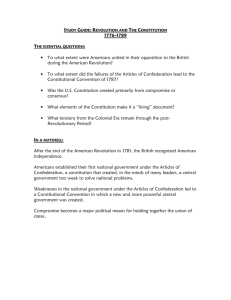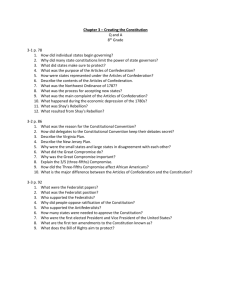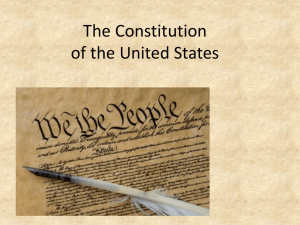Chapter 3: Steps Leading to The Constitution
advertisement
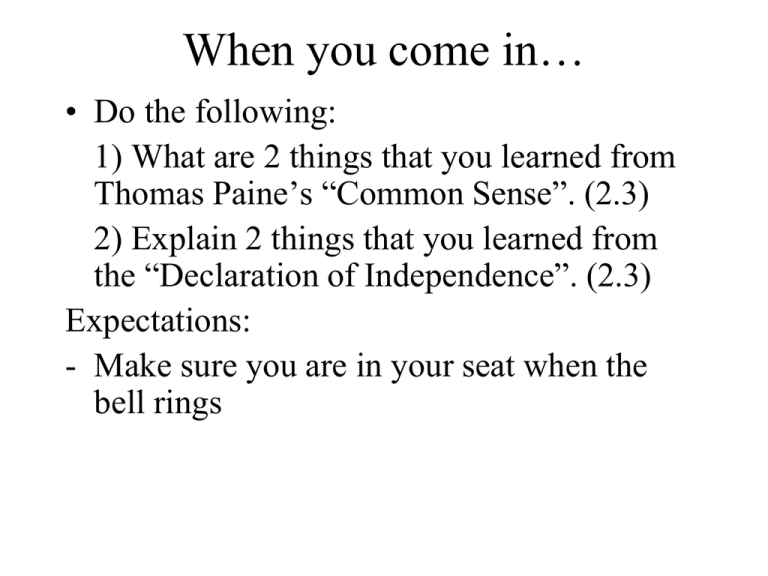
When you come in… • Do the following: 1) What are 2 things that you learned from Thomas Paine’s “Common Sense”. (2.3) 2) Explain 2 things that you learned from the “Declaration of Independence”. (2.3) Expectations: - Make sure you are in your seat when the bell rings Creating your own Declaration • Using the structure created by the Declaration of Independence, write your own ideas about gaining independence from something – school, home life, etc. Make sure to have: 1) Preamble – opening sentence explaining what it’s about 2) Declaration of Rights that you have (3 rights) 3) Grievances (have 3 problems) and who to blame 4) Resolution (1 sentence), what you would like to do 5) A Signature from you Steps Leading to The Constitution (2.4) State Constitutions, Articles of Confederation, The Creation of the Constitution State Constitutions • Replaced old colonial charters and governing bodies • States had bicameral (2 house) legislatures that made laws • States had a governor, who enforced the laws • States had judges and courts, who interpreted the laws State Constitution Ideals • Based on the Declaration of Independence by providing life, liberty, and pursuit of happiness • Most had a bill of rights and guaranteed certain freedoms The First National Government • Called the Articles of Confederation • Created because states could not do some things on their own, such as maintaining an army • Approved in 1791 by all 13 states The Articles of Confederation • Group of state governments that banded together • Had a unicameral (one house) legislature where every state got a vote • States gave it no power to enforce laws and no power to tax Articles Accomplishments • Treaty of Paris in 1783 with Britain • Ordinance of 1785 arranged land into townships allowing settling of the West • Northwest Ordinance (1787) organized the new Northwest Territories and set precedent for admitting new states into the union Land Ordinance of 1785 Northwest Ordinance Articles Failures • Lack of Power and Money (can’t collect taxes, regulate trade, enforce laws) • Lack of Centralization (no single leader, no national courts) • Rules are too Rigid (all states had to agree to pass any laws, nothing got done) The Beginning of the End of the Articles of Confederation • Debt – Congress can’t collect taxes and the country ran up a huge deficit, causing concerns about the government • Shays’s Rebellion – riots broke out due to money issues and one led by farmer Shays attacked a federal outpost, which sent fear about the lack of security given by the government The Philadelphia Convention • After Shays’ Rebellion, many begin calling for a new government and a convention is called • The 55 delegates that arrived were educated men with lots of experience Decisions on Procedure • George Washington was elected to lead the convention • Each state would have one vote at the convention and a majority would decide any issue • The convention was to be kept secret The Need for a New Constitution • At first the delegates were going to revise the Articles, but realized they had to write a new constitution • Thus the meeting became known as the Constitutional Convention When you come in… • Draw a chart that shows two positives of the Articles of Confederation and two negatives of the Articles of Confederation. (2.4 sheet) • Expectations: - Get to your seats before the bell rings Positives Negatives Suggestions for the Convention • Delegates at the Convention have decided to create a new Constitution. They have asked your state how to solve the following problems caused by the Articles of Confederation: 1) Lack of money (too much debt) 2) Lack of a leader 3) Lack of power for the national government 4) Lack of ability to change laws quickly Expectations: - Answer each in a sentence - If you have a partner, only one of you needs to write it down Constitutional Compromises – Structure of National Government • Side 1 – Virginia Plan - Two houses, both represented by population • Side 2 – New Jersey Plan - One house, each state is represented the same • Compromise – Great Compromise - Two houses, one represented by population and the other by state Constitutional Compromises – Should Slaves Count? • Side 1 – North - Slaves should not count as population • Side 2 – South - Slaves should count as population • Compromise – 3/5 Compromise - 3 out of every 5 slaves count as population Constitutional Compromises – Foreign Trade and Slave Trade • Side 1 – North - Government should regulate trade • Side 2 – South - Government should not regulate trade because it would interfere with slave trade • Compromise – Slave Trade Compromise - Government can regulate trade except for the slave trade Constitutional Compromises – Electing the President • Side 1 – “Trust the People” - People should elect the President • Side 2 – “Don’t Trust the People” - Electors from States should elect the President, not people • Compromise – Electoral College - People elect the electors, who vote for the President Constitutional Compromises – Power of the Government • Side 1 – Federalists - Strong National Government is needed, Constitution is good • Side 2 – Anti-Federalists - Strong State Governments are needed, Constitution is not good • Compromise – The Constitution with Bill of Rights - Constitution passes, Bill of Rights is promised What side are you on? • Using information that you know about your state, create a pamphlet with the following (individually): 1) Front Page – Name of State and a drawing of what your state looks like (you may look this up) 2) Page 2 – List the total population of your state and in 3-4 sentences answer…Are you a large or small state? Do you prefer the Virginia or New Jersey Plan? Why? 3) Page 3 – List the slave population of your state and in 34 sentences answer…Compared to other states, do you have a lot of slaves? Do you think slaves should count as population or not? Why? 4) Back Page – List whether your state is in the South or North and in 2-3 sentences answer…Should the government regulate foreign trade? The slave trade? Why? Federalists v. Antifederalists • • - Limited Government Federalists: Fewer limits on government Antifederalists: More limits on government WINNER: FEDERALISTS Federalism (sharing of power) Federalists: States and National government share power - Antifederalists: States should have more power - WINNER: FEDERALISTS Federalists v. Antifederalists • Popular Sovereignty - Federalists: People shouldn’t elect everyone - Antifederalists: People should elect all representatives - WINNER: FEDERALISTS • Bill of Rights - Federalists: Bill of Rights is unnecessary - Antifederalists: Bill of Rights is needed - WINNER: ANTI-FEDERALISTS When you come in… • Explain the two sides and eventual compromise for 3 different compromises on the chart (2.5) • Expectations: - Be in your seat when the bell rings - Turn in any work that you have completed Constitutional Compromises • With the state you have divide up the following: 1) Person 1 - Using the information provided to your group answer the questions on the sheet from your state’s point of view 2) Person 2 – Write a 3 paragraph letter back to James Madison explaining what your state believes about each of the first 3 compromises. For each you must have 1 sentence explaining what side you are on and at least 2 sentences explaining why you take that side. Take into account your size and slave population. Constitutional Compromises • As each group presents their preference, mark what they believe on the tally chart • The reflection part on the other side of the sheet is HOMEWORK tonight The Constitutional Compromises (2.5) Topic Side 1 Side 2 Gov’t Structure Slavery and Pop. Foreign Trade Electing President Virginia Plan North New Jersey Great Plan Compromise South 3/5 Compromise South Slave Trade Compromise Don’t Trust Electoral People College Compromise North Trust People Compromise Federalists v. Antifederalists • Using the information from the chart and worksheet, answer questions 1-15 on the other side of the sheet by putting an F for Federalist or an AF for Antifederalist • Expectations: - Work on this individually with NO talking - You have 10 minutes Outline of the Constitution • Complete the outline on the sheet by using the Constitution in the Civics Today book • Expectations: - Complete the sheet independently - You have 15 minutes Before you leave… • Look at the chart on p.81 and list 2 similarities and 2 differences between the Articles of Confederation and the Constitution. • Expectations: - Remain in seats until the bell rings Which side are you on? • With the people in your state: 1) Explain which region (South, New England, Middle) your state is in and if they are a large or small state 2) Would your state support the Virginia Plan or the New Jersey Plan? Why? 3) Would your state support slaves being part of the counted population or not? 4) Would your state support the regulation of foreign trade or not? Why?

